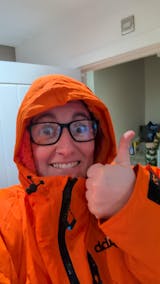Mark and Matt were talking the other day, and it felt useful to get Matt to share some of the mysteries of product development after nearly 30years of working in this area… and frankly Mark is no expert in this end of the supply chain… but every day is a school day!!
Mark: “So, Matt… talk me through how a garment gets developed?”
Matt: “There are many points that need to be factored in when going about this process, and this can vary by garment type dependent upon levels of complexity, a tee shirt being relatively simple to a coat being far more complex. But that said the process is essentially the same. I’ll use the Sea Monster changing robe to briefly outline the process up to the bulk production start stage.
The start point was talking to our potential customers, and asking them what they loved, and also what they would like to improve on changing robe's such as Dryrobe, then taking the idea into a design brief, factoring in all the features and benefits that we wanted to achieve whilst keeping in mind the end use and price point. That was the easy bit!
For the Sea Monster, we wanted to produce a high quality, value garment, and built to last, that had credentials that would put it head and shoulders above other alternatives available on the market. It is a crowded market, with leading brands such as Dryrobe, so it had to be well made, sustainable, offer high performance and functionality, but lighter weight without compromising durability and warmth. I also needed to be practical and look good!
To make the Sea Monster we selected a manufacturer that I had worked with for 20 years that was tried and trusted, not just for reliability, technical capabilities and quality of make, but for the social and ethical standards they apply to their business and factories, certified and verified by international third parties such as SGS.
We then went about sourcing fabric and trims (zips, velcro etc) that met the required performance and end use criteria. For the outer fabric we purposely used a ripstop fabric, known for its great strength to weight ratio. We selected a more durable high performance membrane coating that offered a high level of waterproofing and being breathable. Importantly the fabric had to be third party certified to confirm that it really was made from recycled materials, in this case, post-consumer plastic bottles. The Sea Monster fabric is certified to Global Recycling Standard (GRS).
Having found all our components, the first development samples were produced and over the months we reviewed and tested several rounds of garment samples for fit, make up and functionality, making modifications and amendments between each round of submissions until finally we were happy that we had achieved all our initial goals. The bulk production could now begin.”
Mark: “Why is it so important to you that the recycled fabric is third party certified to an internationally recognized standard such as GRS?”
Matt: “Over the last few years there has been a huge increase in interest and demand for fabrics made from recycled materials. At the same time I have seen a big increase in the number of fabric mills offering recycled fabrics but on occasion have had cause to question whether the fabrics really are made of what they proclaimed to be. Having third party certification to an internationally recognized standard gives visibility and greater certainty.”
Mark: “And how about the term Waterproof… what does that really mean?”
In the UK for a fabric to be classified as waterproof and not just water resistant it has to meet a particular performance test standard, called a “hydrostatic head” of 1500mm. This is measured by placing a 1” by 1” square tube over a piece of fabric and filling it with water until the water starts to seep thru. The height of the water in the tube in mm is used to measure the level of waterproofing. Our fabric is 3rd party tested and achieves a minimum hydrostatic head of 5000mm, more than enough to meet the minimum requirement and right up there with high performance materials.
Another factor to be aware of is the construction of the garment. Although the fabric may be waterproof, if a garment does not have taped seams, then there is a strong chance that water can leak in at these points. The term “taped seams” refers to a thermoplastic tape that is applied to the seams by heat and pressure where the garment has been stitched together to form a waterproof barrier. (Its also important to apply the same technique at any area with external embroidery!) Our garment has both taped seams and taped embroidery.
Mark: "Why is it important for your factory to have been 3rd party socially audited to an international standard?"
Over the years I have visited many factories across Europe and Asia and in that time seen many well run, organized and managed set ups. But equally I have also visited some factories that I wouldn’t dream of working with.
By having a third party social audit we can get an unbiased review of a factories practices according to local laws and international standards and be able to make a decision from a social perspective whether we are happy to be partnering with them and manufacturing goods there. Some of the key areas an audit covers are that the factory has not hired child labour, the workers are not compelled to work there forcibly, their health is fine, their wages and hours meet local laws. The audit also checks that they are allowed proper breaks, there is no harassment in the workplace, they are provided a healthy working environment and there is equality in the workplace.


